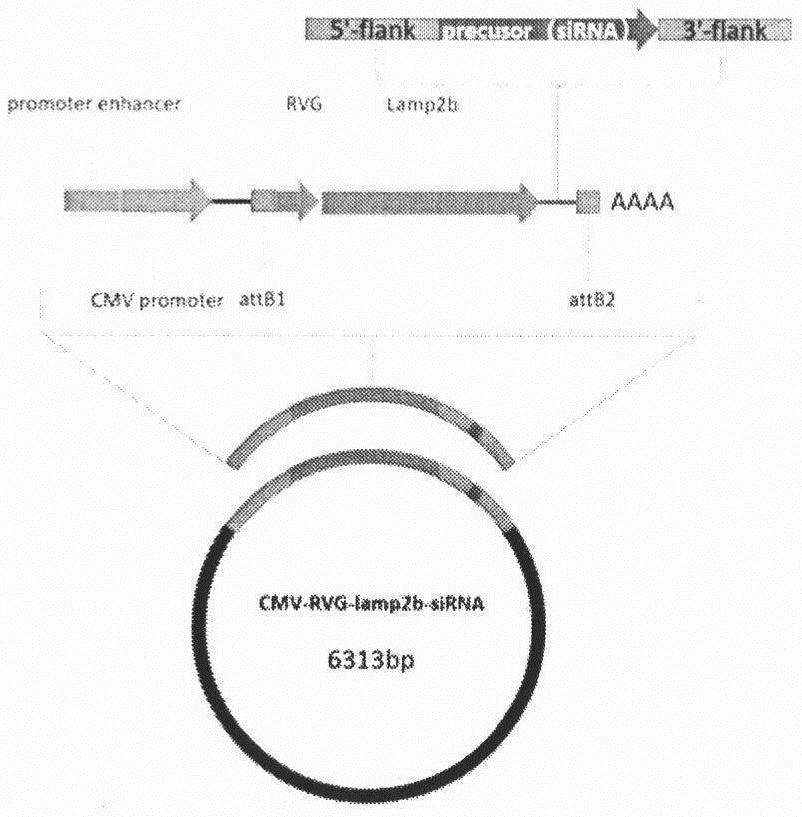Targeted siRNA expression plasmid aiming at LRRK2 and application of siRNA expression plasmid in aspect of Parkinson's disease
A gene expression and sequence technology, applied in the application field of the method in the treatment of Parkinson's disease, can solve the problems of high price and trauma of ASO, and achieve the effects of low cost, improvement of abnormal behavior and alleviation of pain.
- Summary
- Abstract
- Description
- Claims
- Application Information
AI Technical Summary
Problems solved by technology
Method used
Image
Examples
Embodiment 1
[0013] Example 1 Construction of LRRK2 siRNA / RVG plasmid and detection of interference efficiency
[0014] We used restriction endonucleases to treat the control plasmid, recovered the linear vector, and used T4 ligase to connect the RVG-LRRK2 siRNA combination fragment to the vector; the obtained ligation product was transformed and spread on the resistance plate; The single clone was picked two days later and sequenced to confirm the correctness of the plasmid sequence. According to this method, three combined fragments containing different LRRK2 were ligated into the vector to form plasmid molecules, which were named LRRK2si-1, LRRK2si-2, and LRRK2si-3.
[0015] The three kinds of plasmid molecules were respectively transfected into the human neural cell line SHSY5Y with a confluence of 60-70%, and the expression level of LRRK2 in the cells was detected by western experiment after 48 hours. The results showed that the two LRRK2 siRNAs had relatively high interference effic...
Embodiment 2
[0016] Example 2 Inhibitory effect of plasmid-expressed siRNA on LRRK2 in vivo
[0017] LRRK2 si-1 and LRRK2si-2 were used for subsequent experiments, and the control plasmid and LRRK2siRNA / RVG plasmid were injected into the tail vein of 3-month-old PD transgenic mice R1441G at a dose of 10 mg / kg, once every two days, for a total of After 7 injections, the mice were sacrificed 24 hours after the last injection, and the brain tissues of the mice were taken for western blot experiments. The results showed that both plasmid molecules could effectively reduce the expression level of LRRK2 in brain tissue in vivo, and the interference efficiency of LRRK2si-2 was higher.
[0018] The 8-week-old PD transgenic mice R1441G were randomly divided into control group and treatment group, and the control plasmid and LRRK2si-2 plasmid were injected into the tail vein of the R1441G mice at a dose of 10 mg / kg, once every two days, and a total of 7 injections , the mice were sacrificed 24 hour...
Embodiment 3
[0019] Example 3 Effect of LRRK2 siRNA / RVG plasmid on exercise ability of PD transgenic mice
[0020] At the same time, we also evaluated the exercise ability of PD transgenic mice. Before administration, we performed fatigue rotarod test and balance experiment on R1441G mice, trained for one day, and then three times a day for a total of three days. Three days of fatigue rotating rod test and pole climbing test. The results showed that the injection of LRRK2 siRNA / RVG plasmid could effectively alleviate the fatigue rotarod test and the deterioration of pole climbing indicators in R1441G mice.
PUM
 Login to View More
Login to View More Abstract
Description
Claims
Application Information
 Login to View More
Login to View More - R&D
- Intellectual Property
- Life Sciences
- Materials
- Tech Scout
- Unparalleled Data Quality
- Higher Quality Content
- 60% Fewer Hallucinations
Browse by: Latest US Patents, China's latest patents, Technical Efficacy Thesaurus, Application Domain, Technology Topic, Popular Technical Reports.
© 2025 PatSnap. All rights reserved.Legal|Privacy policy|Modern Slavery Act Transparency Statement|Sitemap|About US| Contact US: help@patsnap.com



